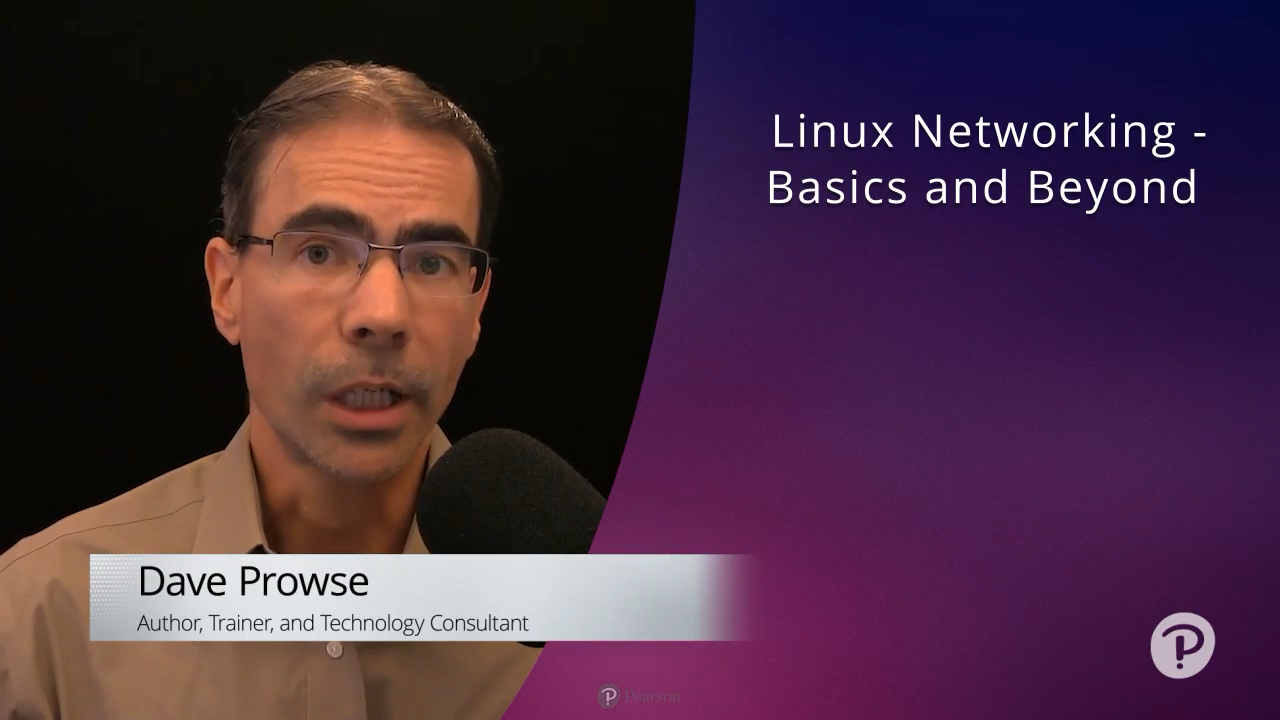Linux Networking - Basics and Beyond (Video Course)
- By Dave Prowse
- Published Apr 10, 2024 by Addison-Wesley Professional.
Online Video
- Your Price: $279.99
- List Price: $349.99
- About this video
Video accessible from your Account page after purchase.
Register your product to gain access to bonus material or receive a coupon.
Description
- Copyright 2024
- Edition: 1st
- Online Video
- ISBN-10: 0-13-835797-8
- ISBN-13: 978-0-13-835797-9
Over 10 Hours of Video Instruction
Learn hands-on how Linux systems communicate and how they are networked together in real-life environments.
Overview:
Linux Networking - Basics and Beyond focuses on using Linux as a server. Most servers in today's networks and on the cloud run Linux in some form or another. For this to work, the servers -- whether physical or virtual -- need to be networked together. With over 8 hours of deep-dive discussions and demos, this video course demonstrates the core concepts of configuring networking on different Linux server distributions with an emphasis on giving you the expertise you need to succeed in your career.
Topics Include:
- Setup and Networking 101 Initial system setup provides recommendations, prepares our systems, and demonstrates how to work with the terminal and text editors. It covers networking concepts including computer networking basics, TCP/IP, the OSI Model, and more.
- Networking Services including the actual networking service used by Debian, networkd and NetPlan used by Ubuntu, and NetworkManager used by Fedora, RHEL, and CentOS.
- Commands and Configurations We'll spend a lot of time here on commands such as ip, ping, dig, and nmcli, as well as hostnames and DNS.
- Connecting between Hosts with the Command Line introduces tools such as SSH, SFTP, rsync, smb, and additional networking tools and services such as wget and curl.
Related Learning:
Sign up for Linux Networking live training with Dave Prowse:
Linux Networking & Security Fundamentals: https://learning.oreilly.com/search/?q=Linux%20Networking%20%26%20Security%20Fundamentals%20prowse&type=live-event-series&publishers=Pearson
Skill Level:
- Beginner, Intermediate
Course Requirement:
- Basic understanding of how to download and install Debian (as a server) into a virtual machine. Examples at: https://www.prowse.tech
- Knowledge of how to set up a virtualization platform such as VirtualBox (or other favorite program). Example: https://www.prowse.tech/virtualbox/
- Ability to work with a Linux editor: vim, nano, etc... (The instructor will focus on vim). Vim introduction: https://www.prowse.tech/vim/
- A virtualization platform of your choice. For example, VirtualBox: https://www.virtualbox.org/wiki/Downloads, or VMware Workstation, KVM, and so on. It is recommended that you utilize NAT mode and not bridged mode. If using VirtualBox, create and select "NAT Network" for your virtual machines networking connectivity.
- At a minimum, download and install the following Linux operating systems into virtual machines: Debian (as a server, no desktop environment): https://www.debian.org/distrib/; and at least one Linux client with desktop environment (Debian, Ubuntu Desktop, Fedora Workstation, etc.) These operating systems will need to be able to communicate with each other and connect to the Internet.
- Go to https://prowse.tech/webinars for details on how to setup your virtual environment and Linux systems.
About Pearson Video Training:
Pearson publishes expert-led video tutorials covering a wide selection of technology topics designed to teach you the skills you need to succeed. These professional and personal technology videos feature world-leading author instructors published by your trusted technology brands: Addison-Wesley, Cisco Press, Pearson IT Certification, Sams, and Que Topics include: IT Certification, Network Security, Cisco Technology, Programming, Web Development, Mobile Development, and more. Learn more about Pearson Video training at http://www.informit.com/video.
Video Lessons are available for download for offline viewing within the streaming format. Look for the green arrow in each lesson.
Sample Content
Table of Contents
Introduction
Module 1. Setup and Networking 101
Lesson 1 System Setup
Lesson 2 Computer Networking Basics
Lesson 3 TCP/IP
Lesson 4 The OSI Model
Module 2. Networking Services
Lesson 5 Introduction to Networking Services
Lesson 6 The networking Service
Lesson 7 The networkd Service
Lesson 8 The NetworkManager Service
Lesson 9 More Networking Services
Module 3. Commands and Configurations
Lesson 10 The ip Command
Lesson 11 Network Testing Commands
Lesson 12 Hostnames and DNS
Lesson 13 nmcli
Module 4. Connecting between Hosts with the Command Line
Lesson 14 SSH
Lesson 15 SCP and rsync
Lesson 16 SFTP & More Connectivity Tools
Lesson 17 Additional Networking Tools
Summary
More Information

